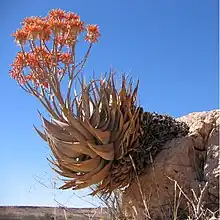| Aloe hereroensis | |
|---|---|
 | |
| Scientific classification | |
| Kingdom: | Plantae |
| Clade: | Tracheophytes |
| Clade: | Angiosperms |
| Clade: | Monocots |
| Order: | Asparagales |
| Family: | Asphodelaceae |
| Subfamily: | Asphodeloideae |
| Genus: | Aloe |
| Species: | A. hereroensis |
| Binomial name | |
| Aloe hereroensis | |
| Synonyms[2] | |
| |
Aloe hereroensis is an African Aloe native to Angola, Namibia and South Africa.[3] Like other Aloe species, it forms a rosette of succulent, lanceolate, greyish-green leaves with teeth along their edges. These leaves can grow up to 40 cm long. A. hereroensis forms large inflorescences, up to 1 meter high, with clusters of scarlet flowers.[2]
References
- ↑ The IUCN Red List of Threatened Species (2019). "Polaskia chende". IUCN Red List of Threatened Species. 2019: e.T110726145A110726157. doi:10.2305/IUCN.UK.2019-1.RLTS.T110726145A110726157.en. Retrieved 23 February 2022.
- 1 2 "hereroensis", Royal Botanical Gardens Kew, retrieved 23 February 2022
- ↑ Chauser-Volfson E, Gutterman Y (1997) Content and distribution of the secondary phenolic compound homonataloin inAloe hereroensisleaves according to leaf part, position and monthly changes. Journal of Arid Environments 37: 115 -122. doi:10.1006/jare.1997.0262
External links
Wikimedia Commons has media related to Aloe hereroensis.
- Dressler, S.; Schmidt, M. & Zizka, G. (2014). "Aloe hereroensis". African plants – a Photo Guide. Frankfurt/Main: Forschungsinstitut Senckenberg.
This article is issued from Wikipedia. The text is licensed under Creative Commons - Attribution - Sharealike. Additional terms may apply for the media files.
